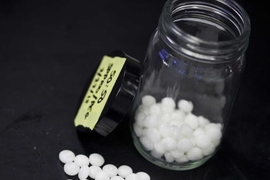When it comes to manufacturing drugs, they do make them like they used to. An April report from the Food and Drug Administration stated that today’s plants differ very little from those in the 1960s.
Bernhardt Trout would like to change that. The director of the Novartis-MIT Center for Continuous Manufacturing is a leading advocate for a more automated, flexible drug production process that allows quality checks (and changes) on the fly. The industry standard batch-based system is hindered by stops and starts, requiring, in some cases, multiple plants for each component of a drug. That approach can lead to delays, and potentially more expensive medicines at the pharmacy.
To push for progress, Trout, who holds the first Raymond F. Baddour (1949) Professorship of Chemical Engineering, is co-organizing the 2nd International Symposium on Continuous Manufacturing of Pharmaceuticals (ISCMP) Sept. 26-27. Supported by the Continuous Manufacturing and Crystallisation Consortium (CMAC) and Novartis-MIT Center for Continuous Manufacturing, the symposium will bring together representatives from academia, industry, and regulators.
The School of Engineering asked Trout about his thoughts on how leading sectors can work together to spur innovation in pharmaceutical manufacturing.
Q: A recent drastic price increase for the EpiPen emergency allergy treatment has shown a spotlight on how medicines are priced and how the drug industry operates. With manufacturing advances, new technologies, and breakthroughs in chemical and biological engineering, why does drug manufacturing seem so out of kilter relative to other sectors?
A: I can answer from the technology standpoint, and in particular, from a manufacturing technology standpoint. The first thing to say is that it is very, very difficult to make breakthroughs in the pharmaceutical industry.
Human biology is extremely complicated, and fantastic new technologies that look promising for years and years can all of sudden fail. Thus, the true cost of a new product is not just the cost of that product, but of all of the failures along the way. Some of those failures are manufacturing failures, which can delay the launch of a product, and given the finite patent lifetime, increase the effective annual cost.
The wonderful thing about continuous manufacturing technologies is that they can help the industry as a whole cut costs.
Q: You are hosting the 2nd International Symposium on Continuous Manufacturing of Pharmaceuticals this week. What progress has been made since the last time you convened the event?
A: In two years, there have been several submissions to the FDA for continuous processes. These are not end-to-end processes, the ultimate vision, but substantial parts of the whole manufacturing process. Furthermore, the momentum in the industry for continuous manufacturing has increased, so we expect more and more submissions.
That the transition, however, has been slow, slower than we would have hoped. I think the industry has been very conservative about innovating in the manufacturing space.
Certainly, there are a number of reasons, including the very high cost of failure, lack of internal incentives in companies for manufacturing innovation, and regulatory issues.
Q: The increasing cost of health care is one of the major issues in the upcoming U.S. election. What advice would you give to the next president to spur advances?
A: I work with most of the largest pharmaceutical companies, and also medium-sized companies and startups. Across the board, I see very bright and dedicated people who care about helping others and want new therapies to keep coming out.
Similarly, the FDA, from bottom to top, has very bright and dedicated people who care in the same way. But the rate of innovation seems to be decelerating. For example, in terms of costs, pretty much everyone agrees that with existing technologies, continuous manufacturing could save 30 percent in manufacturing costs — and that’s without even the additional potential savings of new technologies. That is $60 billion per year savings in the United States alone.
Yet, if there are all of these good people and all of the potential savings, why is it so far from being exploited? The next president should go about regulatory reform and potentially create tax incentives for investing in innovation. Further, the president should actively work against the demonization of the industry by certain politicians. Yes, certain companies have made mistakes and done bad things, but that is true in many industries.
The industry as a whole provides great benefits to the country and the world. Let’s have the public and the pharma industry work together, not against each other. To accomplish that and unleash tremendous dormant potential would take bold, smart leadership.










